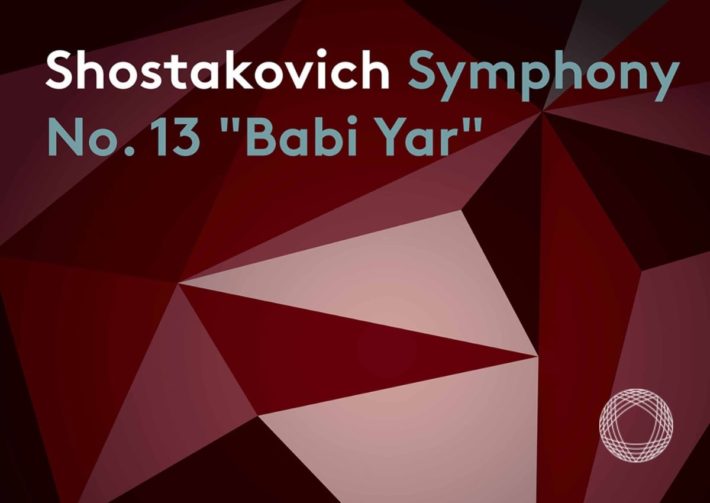A thorough reading of the exceptional written booklet essay by Pauline Fairclough seemed important, because in a particularly powerful way, any fully successful performance of this Symphony must be rooted in the fury and disgust we feel at the work’s origins – the Babi Yar massacre. Shostakovich paints with broad brush strokes in bold, vivid colors, intent on making us feel uncomfortable and difficult emotions. The symphony is not, nor can it ever be, an easy listening experience.
In January 2020, the Chicago Symphony under Riccardo Muti released a recording of this symphony that has met with a considerable amount of acclaim. Muti’s performance is the slowest on record (68 minutes), but its white-hot intensity leaves the listener emotionally and spiritually exhausted, just as Shostakovich intends. One can also turn to the Royal Liverpool Philharmonic under Vasily Petrenko; while the playing and singing may not match the exalted work heard in Chicago, the performance is deeply felt, poignant and often chilling.
So how do Karabits and his Russian forces compare? The first movement is certainly an important litmus test, being some of the most intense music Shostakovich ever composed. Karabits ensures that every note is executed with precision, and the melodic lines are shaped with care. The choir’s initial entrance (track 1, 1’03”), hushed and expectant, quickly builds to a powerful climax. Bass Oleg Tsibulko’s first entrance reveals him to be a thoughtful and sensitive interpreter as he utilizes a large dynamic range and varied colorings to communicate the poem’s denouncement of anti-Semitism. But it all comes across as cautious or overly manicured.
Take, for example, the passage where the bass sings: “Persecuted, spat on, slandered…women squeal and poke their parasols into my face” (3’12”). Shostakovich’s word setting is mostly syllabic, using a small-medium range, so that the soloist and choir can make us almost feel the spittle and wince at the sarcastic mocking. While Tsibulko sings with great tonal weight, he is almost too beautiful, as are the orchestral interjections. Just compare the same passage in Muti’s reading (3’33”).
Related Classical Music Reviews
- Review: Shostakovich – Symphony No. 11 – BBC Philharmonic – Storgårds
- Review: Vadym Kholodenko Plays Prokofiev’s Solo Piano Music
- Review: Rimsky-Korsakov – Orchestral Works – Oslo Philharmonic, Vasily Petrenko
Pentatone’s engineering also contributes to this issue. There is clarity and depth to the soundstage and orchestral balance is wonderfully managed. But the sound never seems to bloom, robbing the climaxes of physical impact. Moreover, the playing sounds smooth-edged, dulling the impact of several passages meant to be edgy and fierce. While this may be Karabits more than the engineers (or a combination of both), it often weakens the effect Shostakovich intends.
The second movement, “Humor,” is more convincing. Karabits and his forces immediately establish a sarcastic mood, ensuring the playful waltz quickly darkens into sarcastic mockery. The diction of Tsibulko and choir is admirably clear.
The last three movements play without a break, bringing a return to the gloomy desolation of the first movement. Doubts immediately resurface with the opening moments of movement three: Karabits is again emotionally reticent, whereas Petrenko instills a more ominous atmosphere in the wandering cello/bass line. At 2’23” in Petrenko’s performance, the percussion mimics knocking on a door, sending a chill down the spine. In this new performance, the knock lacks presence in the overall sound, so the dramatic effect is lost.
The emotional temperature changes in the final two movements: the menace that was lacking at the beginning of the third movement is now present, the percussion creating a palpable sense of dread. The wind playing seems to have greater character and the brass powerfully stentorian. The recording was done in November 2017 – did something suddenly click that was missing in the first few days of recording? The engineering seems different in this movement, with climaxes given room to grow. Surely it must have felt different for the performers – one is left wishing they had re-recorded the first movement again.
I wish I could recommend the recording unreservedly, as I greatly admire this conductor and orchestra. But the readings by Petrenko, Wigglesworth and Muti are more wholly successful than this new release.

Shostakovich – Symphony No. 13 (“Babi Yar”)
Oleg Tsibulko – Bass
Popov Academy of Choral Arts Choir
Kozhevnikov Choir
Russian National Orchestra
Kirill Karabits – Conductor
Pentatone, CD PTC5186618
Shostakovich – Symphony No. 13 – Recommended Comparisons
Read more classical music reviews or visit The Classic Review Amazon store
Follow Us and Comment:
[wd_hustle id=”HustlePostEmbed” type=”embedded”]











